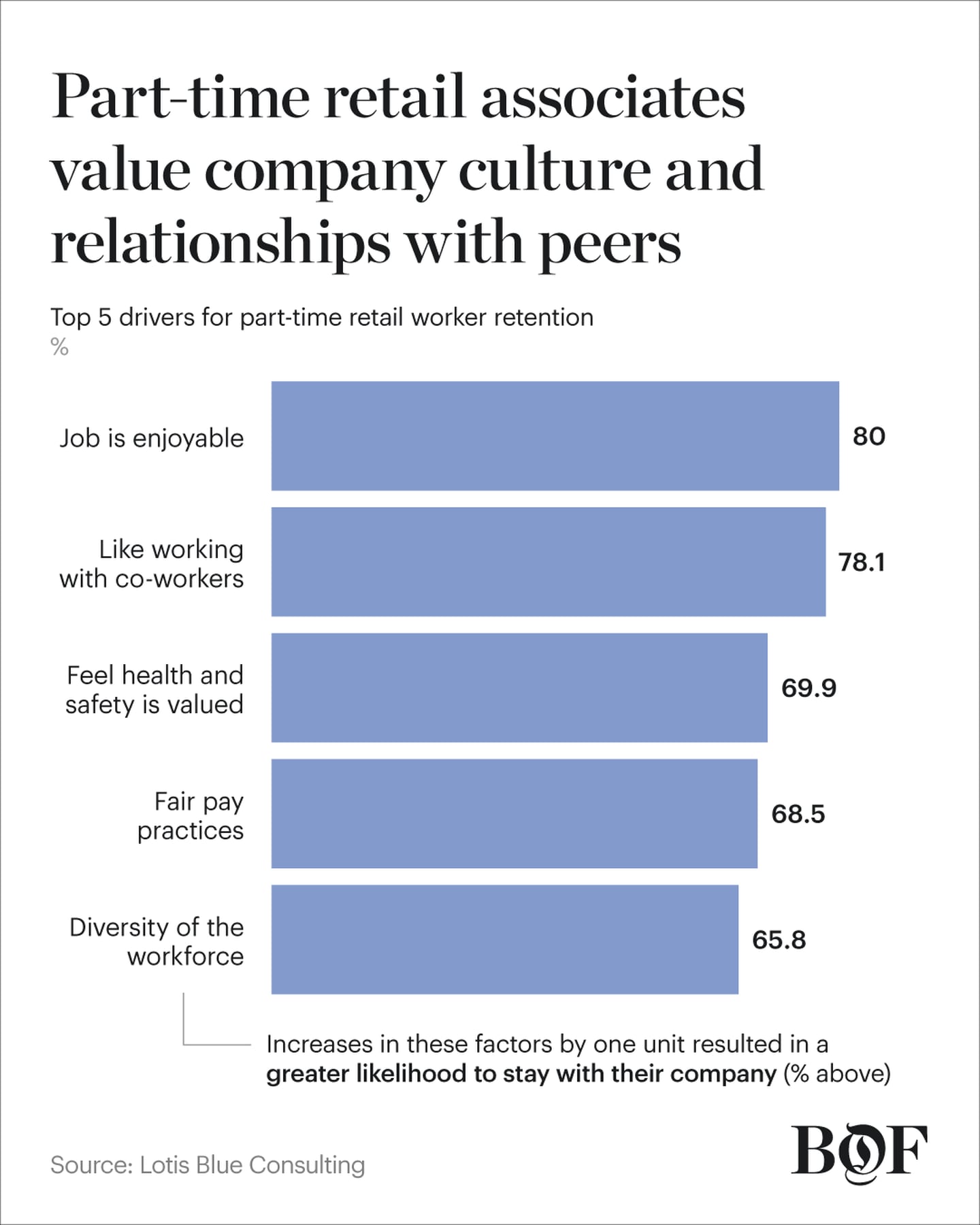
Alexandra has worked part-time as a store associate at the same big, American fashion brand for more than a decade. But lately, she’s been feeling checked out.
She said she takes shifts partly for the generous employee discount, partly to pad her savings and to afford the occasional splurge on dinner with friends, while her work as a media consultant pays the bills. (Alexandra asked that her last name be withheld since she is not authorised by her employer to speak to the media.)
But there are downsides. As a part-timer, Alexandra said she can’t always get as much work as she’d like. She also misses key meetings where she might learn the new way to fold jeans, or changes to the break policy. As a result, it’s not uncommon during a shift for her to be chastised for breaking a rule she didn’t know existed.
“There’s just not a lot of support from corporate to address issues that happen in the stores,” she said. “I now only work four hours a week … I’m not here enough to put in the effort it would take to pursue resolutions.”
Alexandra’s experience represents the best and worst of being part of fashion’s part-time workforce. In an industry where demand is often seasonal and margins are thin, the flexibility to quickly staff up – and down – is baked into countless companies’ financial models. Part-time workers are also cheaper, as they are often paid less and typically aren’t eligible for health insurance and other benefits.
But the bill may be coming due. The reliance on part-time workers is a major factor behind fashion retail’s reputation for low wages, unpredictable schedules and mind-numbing tasks. In a tight labour market, where fewer people feel the need to take part-time jobs, that’s made it harder for some stores to find enough employees, even as they raise wages and offer perks like wellness benefits and tuition reimbursement.
Few employers appear to be reducing their reliance on part-time workers, however. Last year, about 28 percent of all US retail employees worked under 35 hours per week, a figure that has held steady for decades, according to the US Bureau of Labor Statistics.
More than ever, retailers must create a compelling value proposition for their part-time workforce, experts say. Often, this starts with acknowledging how the needs of their part-time employees differ from full-time and salaried employees, said Preethi Prasad, a partner in Kearney’s leadership, change and organisation practice. For instance, compared to their full-time counterparts, part-time associates often value peer relationships and company culture more than health benefits and paid time off, research shows. They also really want to have a voice in the company to offer feedback and to feel like they’re an integral part of the organisation — even if they’re only clocking in a few hours a week, Prasad said.
It’s more than just the right thing to do for the workers — customers notice when store associates are miserable and it can significantly shape their shopping experience. (Alexandra, for instance, said feeling undervalued and disconnected has led her to give less effort to her work — some days, the bare minimum.)
“What’s really at stake is profitability,” said Louise Clements, chief marketing officer at WorkJam, a software application for retail workers. “When you don’t prioritise the experience of your part-time employees, your customer experience is going to suffer.”
What do part-time workers want?
Most people take part-time jobs by choice. According to the BLS, only 13 percent of retail employees working under 35 hours would prefer full-time work. The other 87 percent include students, retirees, stay-at-home parents and workers like Alexandra who have full-time employment elsewhere but need extra cash.
Many retailers don’t extend traditional benefits like health care coverage, retirement savings or stock options to their part-time staff. That “puts a premium on some of the more cultural and experiential benefits that they get from the work,” said Erica Grant, partner and head of the leadership & talent practice at business advisory firm Lotis Blue Consulting.
Trendy fashion brands historically have been able to hire part-time staff who work because they love the label (and the discount they get from spending even a few hours a week on the sales floor).
Indeed, health benefits and an ability to take time off are the least important factors in whether part-time retail employees leave or stay at their jobs, Lotis Blue Consulting’s 2024 Future of Retail Workforce study. The biggest drivers for part-time employees retention are: job enjoyability, camaraderie with colleagues, and company values like diversity and inclusion and sustainability, a separate analysis for BoF by Lotis Blue Consulting found.
“A large degree of this population is choosing to work for a retailer that for whatever reason, they have a sense of alignment with the retailer’s value proposition or their products,” Grant said.
What causes part-time employee turnover?
Because part-time work is often a choice, these workers often cite different reasons for walking away (though pay and hating your manager are reliably among the top reasons people quit).
Lotis Blue found a company’s poor sustainability practices were the biggest driver of turnover — perhaps reflecting the fact that part-time workers tend to be younger than full-time, salaried employees.
Not feeling like they belong or are an integral part of the company culture are also significant drivers for part-time workers who quit. In Alexandra’s case, her limited weekday availability means she expects to miss a few meetings here and there, but the fact that no one remembers to fill her in sends the message that she’s not valuable, she said.
“A big part of the issue is [part-time employees] don’t have a loud enough voice,” Prasad said. “It’s up to retailers to figure out how to incorporate them into the pulse of the organisation … Because whether they’re full-time or part-time, [all] employees are still your greatest asset.”

How can retailers improve the experience of their part-time employees?
As much as possible, companies should include part-time employees in all team-building exercises and company celebrations at the store level and provide effective outlets for them to share feedback — regardless of how few hours they’re in the store. Retailers should also emphasise (without exaggerating) how they’re accomplishing their objectives in areas such as sustainability and diversity, equity and inclusion.
At a minimum, part-time employees should have access to the same training and development opportunities as their full-time peers — not only so that they feel included in the company culture, but so they have all the tools and resources to offer the same level of customer service as their full-time counterparts. This also ensures that the company can identify talent in their part-time ranks who may be a fit for bigger roles within the organisation.
Retailers have to get savvier about how they disseminate critical information to their part-time associates. “Bulletin boards in the breakroom” or relying on the whim of stretched-thin store managers won’t cut it, Clements said.
Newer technology platforms and applications can help ensure all workers have access to information that helps them perform their jobs, stay compliant with legal requirements, and even learn new skills to move up in the organisation if that’s an objective, she said.
“Whether they’re full-time or part-time, the cost of replacing talent when they leave is significant,” Clements said. “Sometimes it’s even more difficult if you’re looking to replace someone who was only working a few hours. Connecting your associates to your culture is critical for your company and for your shareholders.”



